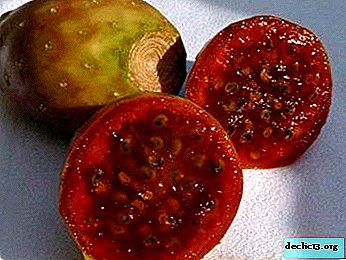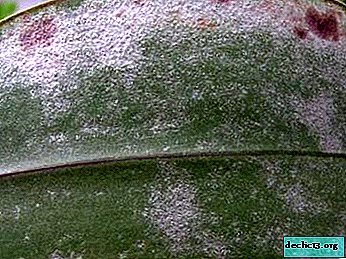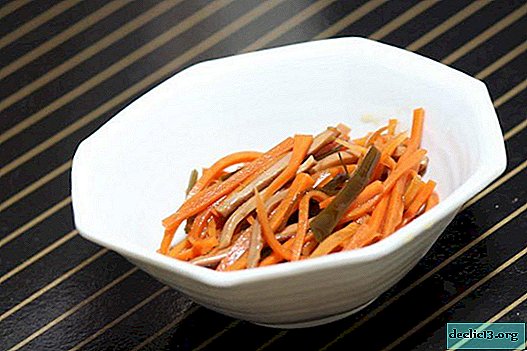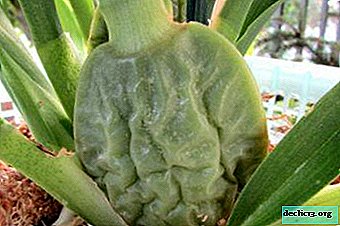For true connoisseurs of plants, the climbing beauty of the rose New Down. Complete Flower Information

The climbing rose New Dawn is very popular all over the world. It is undemanding to the growing conditions, and therefore each grower is able to grow it.
Rosa "New Dawn" is a variety that belongs to the class climbing large-flowered roses, and is a hybrid of the Vishurana variety. It is also one of the most unpretentious and frost-resistant climbing roses.
Detailed description
Variety New Down belongs to strong-growing climbing roses. Long hanging shoots are strewn with many spikes. The smooth surface of small leaves is saturated green and prone to darkening.Flowers are most often single, but there are also 5 pieces collected in brushes. Blooming light pink pointed buds take on a cup shape with a diameter of 10-12 cm. When they are fully opened, the flowers become creamy white with a pink tint, lush, smell like a tea rose. Their petals are concave and convex.
We offer you to watch a video about the New Dawn rose:
Photo
Below you will find a photo of the climbing beauty of a New Down rose.




History of occurrence
Rose New Dawn is a hybrid of the Vishurana variety. It was bred by the method of kidney mutations of the famous climbing rose "Dr. W. van Fleet". New Down was first introduced in 1930 in America. Today it is the most common climbing rose.
What is the difference from the other climbing species?
- New Down variety is highly resistant to frost and disease.
- The flower petals of this rose do not deteriorate under the influence of the scorching sun and heavy rain.A feature of the rose is that it changes color depending on the weather. In sunny weather, snow-white, and in cloudy and cool become a pronounced pink hue.
- New Dawn's climbing rose is distinguished from other climbing varieties by its excellent ability to weave and self-clean, that is, after the flowers bloom, the petals themselves fall to the ground.
Bloom
First, flowers at the New Down rose appear on old shoots, and then on young ones. Flowering begins in June and lasts a long time. It happens that before winter itself it is strewn with flowers. Although they last only 2 days, but there are so many of them, it seems that the bush blooms without interruptions. For so that the rose looks neat, buds that have bloomed can be removed.
The lack of flowering is due to several reasons. It could be:
- soil depletion;
- lack or excess of nutrients;
- lack of light;
- the presence of many shoots near the roots;
- various diseases.
Step-by-step care instructions
- For the New Down climbing rose you need to choose a well-lit, sheltered from drafts and wind.
- If a flower is planted in order to hide the wall, then the hole must be dug half a meter from the wall. If, in the future, a support is provided, then the hole is placed 20 cm from it. When planting, the roots are located opposite the support, and the flower is inclined to it.
- It is not recommended to plant in places where the rose grew. The fact is that there the soil is already depleted, and most likely there are pests in it.
 When close to the surface of the earth groundwater, the bush must be planted on special elevations.
When close to the surface of the earth groundwater, the bush must be planted on special elevations.
The soil is suitable for a climbing rose New Down:
- permeable;
- not heavy;
- loose.
The flower can be planted from April 20 to May 20, or from September 1 to October 10. Plus planting in the fall is the faster development of cuttings in the spring. In stores, you can buy New Down rose seedlings with basal soil. Before you plant them you need:
- Inspect the roots, untangle them, straighten.
- Put in water for 3-4 hours.
- Then dig a hole with a depth and width of not less than half a meter.
- Ready soil can be bought at the store. It already has all the nutrients. If this is not possible, then rotted manure, compost should be poured into the bottom of the pit, plant a seedling and sprinkle with fertile soil on top.
- Water carefully so that water is absorbed into the soil. The vaccination site should be below ground level.
It must be remembered that the roots can be very deep. In the absence of rain, as well as in hot weather, the flower is watered 2-3 times a week. At the end of August, watering is reduced, in the future it is stopped.
- It is important to feed the New Down climbing rose with fertilizers, alternating organic and mineral compounds, you can use herbal infusions or mullein. The evening time is suitable for this procedure.
- When active flowering begins, it is not necessary to use compounds that contain nitrogen.
- Each decade, it is advisable to carry out foliar dressing using potassium humate, sometimes you can add wood ash.
It is necessary to fertilize the New Down climbing rose after watering or rain, strictly observing the norm.
To rejuvenate the bush is necessary:
- systematically remove 5 year old shoots that have already become coarse;
- In spring or autumn, sanitary pruning is performed, in which thin and dried branches are removed.
If you form a bush from the very beginning, then in addition to becoming beautiful, it will be easier to take care of it.
 In the New Down variety, flowers appear on any shoot in the first year. To maintain climbing, shoots are advised to leave without shortening for the winter. Trim carefully. If you do it low, then the bush will turn out to be a tea-hybrid, at the level of 1.5 m it will acquire an excellent climbing shape.
In the New Down variety, flowers appear on any shoot in the first year. To maintain climbing, shoots are advised to leave without shortening for the winter. Trim carefully. If you do it low, then the bush will turn out to be a tea-hybrid, at the level of 1.5 m it will acquire an excellent climbing shape.
So that flowering shoots do not touch the ground, the bush is advised to tie. You can use any method:
- For example, plant near the lattice, then tie to it and direct the shoots.
- Another way is to fan the stems, leaving the side shoots free. They will grow up and to the sides.
- In order for the lashes of the weaving rose New Down to begin to wrap around an arch or pillar, you need to direct them around the support and tie them up in a spiral.
- First, the rose is removed from the support, all leaves are removed and the integrity of the shoots is checked. If there are more than 10, then cut out:
- old
- weak
- sick.
- All shoots must be connected, try not to break, bend to the ground and fix. To fix, use pegs.
- Then the bush of roses needs to be spudded and sprinkled on top with sand or earth. That soil, which is near the roots, you do not need to take, so that they do not accidentally open.
- It is advisable to cover everything with plastic wrap.
How to propagate?
New Down climbing rose propagated by cuttings. With this vegetative method, the qualities of the variety are preserved.
- To do this, in August, cut the cuttings that were formed this year. Choose those shoots that are a little stronger, but not quite young. They should have about 3 leaflets, those that are located below are removed, and leave only one on top.
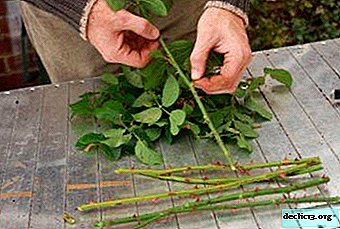 Before planting in the ground, it must be watered.
Before planting in the ground, it must be watered.- Then, at a distance of 20 cm from each other, deepen the cuttings so that only the remaining sheet is visible.
- From above, you need to build a greenhouse, taking plastic bottles for these purposes. Leave the covers open for free air circulation.
- Sheltered cuttings must be watered until winter.
- In the spring, leaflets and new shoots will appear on them.
- If the bushes are strong, then you can plant it, if not, then leave it at this place for another year.
Diseases and Pests
- More often than not, the climbing rose New Down falls ill with powdery mildew and cancer of the bark. For prevention and treatment, a Bordeaux mixture is used. It is also necessary to timely remove diseased shoots, and then burn them.
- Such insects as spider mites and aphids bring harm to the New Down rose. To reduce the risk of infection, the aerial part should be treated with infusion of horsetail and nettle.
The New Dawn variegated rose will be a real decoration in the garden. For this you need to put her in a suitable place, and in the future to fulfill the minimum requirements for care. Then the rose with its flowers will delight the eye for a long time.

 Before planting in the ground, it must be watered.
Before planting in the ground, it must be watered.

